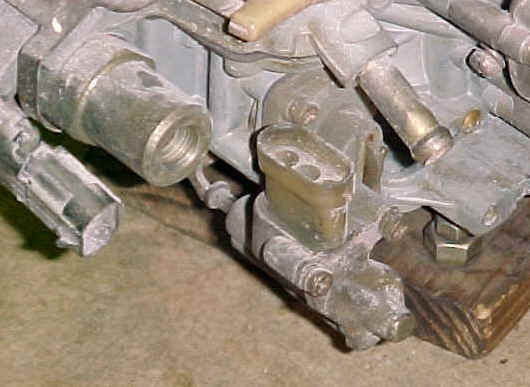
The 1981 through 1987 Chevrolet Chevette Gasoline cars built for sale in the U. S. were equipped with a Holley 6510 Computer Feedback Carburetor.
The Holley 6510 Computer Feedback carburetor used on the Chevette 1.6 L engine has a TPS ( Throttle Position Sensor ) located on the accelerator pump housing, and looks like this:

Below is some great advice and information provided by World Renowned Chevette Expert, Shawn Begin, otherwise known as "Chevette Zealot", shown here with his "Spirit of '76" Chevette !

"Well, you've come to the right place. I just happen to specialize in GM ECM diagnosis..... "
First, there is no fuel pump relay on these cars, so that's out of the question. Basically, your ECM (computer) sees less than .7 volts from your TPS. Either the wiring is bad, connections are bad, or the sensor has gone open internally. First, check that the TPS connector is on the TPS (located on the carb.) Make sure the connection is clean and tight. follow the wiring back to the firewall, make sure there is no chafing or breaks in it. And finally (with the battery unhooked) push in the connectors on the computer to make sure they are tight. Next, You must check the TPS. First, locate the TPS's connector. There will be 3 wires coming out of it: black,dark blue, and gray. Turn the ignition switch on, but don't start the engine. Black is ground, make sure this one works /w a test light hooked up to 12v+. Gray should be 5+ (4.7 or more should suffice) volts (been a while since I did a chevette CCC system.) Check it with a DIGITAL voltmeter. An analog one (needle moves) will draw too much current and kill the 5+ regulator in the ECM. Use the black ground wire to ground the meter, and carefully probe the 2 other terminals. there should be 5+ present there. If not, your ECM is either faulty, or the connections are bad back to the computer. Check your Coolant Temp sensor to see if 5+ is present there across its terminals. This will confirm whether or not the computer is bad, if 5+ is not present at the TPS. If you get it at the CTS and not the TPS, check the wiring, and make sure the connections on everything are clean and tight. You can also check voltages at the computer with it plugged in still. (do the above first). Unplug the TPS, turn the key on and Look for a gray wire on Terminal #15. Use this for the + wire on a DIGITAL meter and ground the other end. You MUST get 5+ here, otherwise the computer is bad. Make sure that no wiring is shorted out before changing the computer. Now, if you have 5+ and a good Ground at the TPS, fabricate some jumpers that will allow you access to the Dark blue wire's signal and the black wire's ground, while still connecting the TPS. first, turn the key on with the TPS hooked up in the above fashion, and read the voltage between the dark blue and the black with a digital meter. it should be between .92-.98 volts when the throttle is on the highest step of the fast idle cam. Next open and close the throttle slowly, the voltage should go up smoothly as the throttle is opened. it should be nearly 5+Volts at WOT. If it fails the above tests, replace the TPS, and then adjust it.
There is a whole slew of stuff on the TPS replacement and adjustment on the old forum, which is located here:
http://venus.beseen.com/boardroom/f/49686/
You can read more of Shawn's wisdom, and other Chevette expert's, on the current Chevette Performance Forum located here: